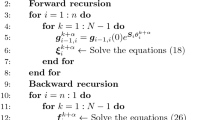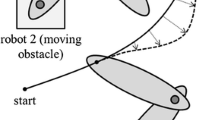Abstract
In this paper, a new method which is a combination of open and closed loop optimal control is developed to find maximum load carrying capacity of nonholonomic wheeled mobile manipulator (WMM) in the presence of environmental obstacles. At first level, open loop control method is used to solve path planning problem and design an optimal trajectory with maximum dynamic load carrying capacity between initial and final point. Optimality conditions are obtained for carrying the maximum payload between two points in an environment including obstacles. The main contribution at first level is applying obstacle avoidance in the objective function that leads to a two-point boundary value problem. At second level, a nonlinear closed loop optimal controller is designed to perform optimal trajectory in real-time conditions. The main contribution at second level is applying the nonlinear Hamilton–Jacobi–Bellman equation to design an optimal nonlinear state feedback controller. Numerical procedure in both levels, that is time consuming, is performed off line and resulted control law is simply applied in real-time conditions. The other contribution of this paper is the combination of these levels; it makes sure that the achieved trajectory and maximum load is applicable. To show the effectiveness of the method, simulations are performed for a planar WMM and a spatial WMM named Scout as well as experimental results for Scout robot.

Similar content being viewed by others
Abbreviations
- O :
-
Center of the world coordination system
- b :
-
Distance between driving wheels and axis of symmetry
- r :
-
Radius of each wheel
- (X, Y):
-
Position of center of mass C in the world coordination system
- \({\theta _{r}}\) :
-
Angular displacement of right wheel
- \({\theta_{1},\theta_{2}}\) :
-
Angular displacement of first and second links
- \({\tau_{1}, \tau_{2}}\) :
-
The torque exerted to right and left wheels
- \({\phi}\) :
-
The heading angle of platform measured from X-axis of the world coordinates
- J 0 :
-
The moment of inertia of mobile platform without the driving wheels about a vertical axis through o
- J 1, J 2 :
-
The moment of inertia of first and second links about vertical axis
- m 1, m 2 :
-
The mass of first and second links
- M w :
-
The mass of each driving wheel plus the rotor of its motor
- V(q, q′):
-
n \({\times}\) n nonlinear terms matrix
- M m :
-
Manipulator inertial matrix
- Q, R :
-
Weighting matrixes for velocity terms and torques
- J(x):
-
Performance index at level 2
- J *, u * :
-
Optimal values of J, u
- c i :
-
Galerkin coefficients
- \({\alpha}\) :
-
Tracking accuracy
- o :
-
The intersection of the axis of symmetry with the driving wheel axis
- C :
-
The center of mass of mobile platform
- d :
-
The distance from C to o
- (X e, Y e):
-
The coordination of end effector in the world coordination system
- \({\theta_{l}}\) :
-
The angular displacement of left wheel
- x :
-
State variables vector
- \({\tau_{3}, \tau_{4}}\) :
-
The torque exerted to first and second joints
- J w :
-
The moment of inertia of each wheel and the motor rotor about wheel axis
- J I :
-
The moment of inertia of each wheel and the motor about the wheel axis
- m 0 :
-
The mass of mobile platform without driving wheels
- m p :
-
The mass of payload
- M(q):
-
n \({\times}\) n inertial matrix
- E(q):
-
n \({\times}\) r fixed matrix
- V m :
-
Non-linear terms matrix in manipulator dynamic equation
- \({w_{jk}^{i}}\) :
-
Weighting matrix related to obstacle avoidance in cost function
- \({\tau _{\rm m}}\) :
-
Joint torques vector
- N :
-
Number of basis functions
- \({\varphi_{i}}\) :
-
Basis functions used in Galerkin procedure
- \({\delta}\) :
-
Convergence accuracy of Galerkin coefficient
References
Yue, S.; Tso, S.K.; Xu, W.L.: Maximum dynamic payload trajectory for flexible robotic manipulators with kinematic redundancy. Mech. Mach. Theory 36, 785–800 (2001)
Korayem, M.H.; Ghariblu, H.: Maximum allowable load of mobile manipulators for two given end points of end-effector. Int. J. Adv. Manuf. Tech. 24, 743–751 (2004)
Korayem, M.H.; Gariblu, H.: Maximum allowable load on wheeled mobile manipulators imposing redundancy constraints. Robot. Auton. Syst. 44, 151–159 (2003)
Ghariblu, H.; Korayem, M.H.: Trajectory optimization of flexible mobile manipulators. Robotica 24, 333–335 (2006)
Korayem, M.H.; Nikoobin, A.;Azimirad, V.: Maximum load carrying capacity of mobile manipulators: optimal control approach. Robotica 27, 147–159 (2009)
Macfarlane, S.; Croft, E.A.: Jerk-Bounded manipulator trajectory planning: design for real-time applications. IEEE Trans. Robot. Autom. 19, 42–52 (2003)
Xu, D.; HuCarlos, H.; Calderonand, A.A.; Tan, M.: Motion planning for a mobile manipulator with redundant DOFs. In: Proceedings of ICIC’05 International Conference on Intelligent Computing, China (2005)
Kelly, A.; Nagy, B.: Reactive nonholonomic trajectory generation via parametric optimal control. Int. J. Robot. Res. 22, 583–601 (2003)
Korayem, M.H.; Azimirad, V.; Nikoobin, A.; Boroujeni, Z.: Maximum load-carrying capacity of autonomous mobile manipulator in an environment with obstacle considering tip over stability. Int. J. Adv. Manuf. Tech. 46, 811–846 (2009)
Van Willigenburg, L.G.; De Koning, W.L.; Chalabi, Z.S.; Tchamitchian, M.; Van Straten, G.: On the selection of appropriate control system design methodologies. In: MRS report 2004-1, Proceedings of the IFAC World Congress (2005)
Korayem, M.H.; Pilechian, A.: Modification of algorithms for determination of dynamic load carrying capacity in flexible joint robots. IEEE Int. Conf. Robot. Biomim. pp. 924–929 (2006)
Gupta, S.; Luh, J.Y.S.: Closed-loop control of manipulators with redundant joints using the Hamilton–Jacobi–Bellman equation. In: Proceedings of International Conference of the IEEE Robotics and Automation, pp. 472–477 (1991)
Kirk, D.E.: Optimal control theory an introduction. Prentice-Hall Inc., New Jersey (1970)
Beeler, S.C.; Tran, H.T.;Banks, H.T.: Feedback control methodologies for nonlinear systems. J. Optim. Theory Appl. 107, 1–33 (2000)
Yamamoto, Y.: Control and coordination of locomotion and manipulation of a wheeled mobile manipulator, PhD thesis, University of Pennsylvania (1994)
Beard, R.W.; Mclain, T.W.: Successive Galerkin approximation algorithms for nonlinear optimal and robust control. Int. J. Control 71, 717–743 (1998)
Korayem, M.H.; Azimirad, V.; Tabibian, B.; Abolhasani, M.: Analysis and experimental study of nonholonomic mobile manipulator in presence of obstacles for moving boundary condition. Acta Astronautica 67, 659–672 (2010)
Author information
Authors and Affiliations
Corresponding author
Rights and permissions
About this article
Cite this article
Korayem, M.H., Azimirad, V. & Irani Rahagi, M. Maximum Allowable Load of Mobile Manipulator in the Presence of Obstacle Using Non-Linear Open and Closed Loop Optimal Control. Arab J Sci Eng 39, 4103–4117 (2014). https://doi.org/10.1007/s13369-014-0974-1
Received:
Accepted:
Published:
Issue Date:
DOI: https://doi.org/10.1007/s13369-014-0974-1




